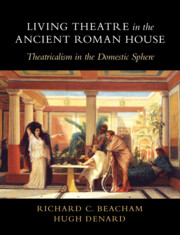Book contents
- Living Theatre in the Ancient Roman House
- Living Theatre in the Ancient Roman House
- Copyright page
- Dedication
- Contents
- Figures
- Acknowledgements
- Chapter 1 Roman Theatricality and Theatricalism
- Chapter 2 Theatrical Life at Pompeii
- Chapter 3 Performance at Pompeii and the Range of Roman ‘Theatrical’ Entertainments
- Chapter 4 Politics and Patronage at Pompeii
- Chapter 5 Theatricalism and the Roman House
- Chapter 6 Skenographia
- Chapter 7 Skenographia at Boscoreale, Oplontis and Pompeii
- Chapter 8 Skenographia on the Palatine and at Pompeii
- Chapter 9 Fourth Style Skenographia
- Chapter 10 Triclinium Theatricality
- Bibliography
- Index
Chapter 7 - Skenographia at Boscoreale, Oplontis and Pompeii
Published online by Cambridge University Press: 22 December 2022
- Living Theatre in the Ancient Roman House
- Living Theatre in the Ancient Roman House
- Copyright page
- Dedication
- Contents
- Figures
- Acknowledgements
- Chapter 1 Roman Theatricality and Theatricalism
- Chapter 2 Theatrical Life at Pompeii
- Chapter 3 Performance at Pompeii and the Range of Roman ‘Theatrical’ Entertainments
- Chapter 4 Politics and Patronage at Pompeii
- Chapter 5 Theatricalism and the Roman House
- Chapter 6 Skenographia
- Chapter 7 Skenographia at Boscoreale, Oplontis and Pompeii
- Chapter 8 Skenographia on the Palatine and at Pompeii
- Chapter 9 Fourth Style Skenographia
- Chapter 10 Triclinium Theatricality
- Bibliography
- Index
Summary
The primary subject of this chapter is the extensive ensemble of Second Style paintings found at two major ’Vesuvian’ villas: that of Fannius Synistor at Boscoreale and the Villa of Oplontis in Torre Annunziata. Together with our team of researchers, we were intensely involved in several international projects both in meticulously examining and analysing the organisation and decor of these villas, as well as creating highly detailed virtual reality 3D models of them. The chapter draws extensively upon the results of such research and work. We discuss further the striking relationship between the atrium paintings at Oplontis and the structural pattern of the scaenae frons, including that at the Large Theatre of Pompeii itself.
Keywords
- Type
- Chapter
- Information
- Living Theatre in the Ancient Roman HouseTheatricalism in the Domestic Sphere, pp. 256 - 314Publisher: Cambridge University PressPrint publication year: 2023

